In a recent public address, Vaccine Czar Carlito Galvez stated that over 3 million Filipinos have been vaccinated since March 1, 2021. But it is still a far cry from the 70 million the government targets to vaccinate by the end of this year to achieve herd immunity.
The Department of Health (DOH) stated its plans to inoculate 100,000 to 200,000 individuals daily once vaccine supplies become stable. But from the 7 million vaccine doses received by the country so far, over 3 million have only been administered nationwide. A tweet from ABS-CBN Data Analytics Head Edson Guido two days ago (May 19, 2021) further brought to light how far the country is from herd immunity. He stated that at the rate we are going, the 70-million target will be achieved in 3 years, and not this year. “We still have a long way to go,” Guido tweeted. “To reach the target of 70 million by end of 2021, the average should be around 600,000 daily. That’s 5.5 times the current pace. We need more vaccines.”
 (screenshot from Twitter)
(screenshot from Twitter)
Adding to the challenges of vaccine supply and vaccination processes is the sensitivity of some vaccine brands. To ensure their safety and efficacy, they need to be maintained in very low temperatures in every step of the way— from their arrival in the airport to storage and delivery. With the country’s limited infrastructure especially in remote areas, vaccine quality may suffer, and along with it, the health of many Filipinos.
 Fr. Nic in the Providence College laboratory (Courtesy: Providence College)
Fr. Nic in the Providence College laboratory (Courtesy: Providence College)
Developing a Different COVID-19 Vaccine
Such issues are what a new type of COVID-19 vaccine hopes to resolve. Fr. Nicanor “Nic” Austriaco, who is developing this product, has taken his cue from oral vaccines such as the one for polio. “It’s not unusual to have oral vaccines,” he explained. “In the Philippines, we have 110 million people in 7,000 islands, and we have to bring the vaccine to them. Right now, all the (COVID-19) vaccines require very cold refrigerators. I want to develop a vaccine that is shelf-stable. In other words, you can put it on the shelf without the need for refrigeration, and it would still last.”
Biology and theology are Fr. Nic’s fields of expertise, having been trained in molecular biology at the Massachusetts Institute Technology (MIT) in the U.S. more than two decades ago. Currently, he is a professor at both the Providence College in Rhode Island and our very own University of Santo Tomas. He is also a fellow at OCTA Research, an independent and interdisciplinary research group of faculty members that has been providing pandemic data for the country.
The vaccine Fr. Nic and his team are developing is yeast-based, with a shelf life of two years even without refrigeration. “The idea is that we take probiotic yeast, which you can buy in drugstores, and we genetically engineered it. We changed it so that it will produce the spike protein of the SARS-CoV-2 virus. This spike protein is the part of the virus that Pfizer, Moderna , AstraZeneca, Gamaleya all put into your body. So, we are just changing the delivery system.” The yeast, which could be drunk or taken in pill form, would stay in the intestines and produce the spike protein, which would trigger the body’s immune system.
Despite the promising benefits of this oral COVID-19 vaccine, Fr. Nic warned that it may take 6 months to a year before it can be released to the public. “This is why I call this a second- generation vaccine. The expectation is we’re going to be vaccinated nearly every year or nearly every other year. So to save the Philippine government [from spending] billions of pesos to be paid every year to foreign companies, we’re trying to develop a vaccine for the Philippines that is relatively cheap but safe and efficacious.”
Fr. Nic named the oral vaccine development as Project Pag-asa, precisely because he hopes to give hope to Filipinos, especially the poor. “I read a story about a Filipino jeepney driver who lost his job, who lost his house because of the first ECQ, and I realized that we have to protect the poor—the poorest kababayans. The first-generation ones will be great for them but if we do this every year for a long time, we need a vaccine that would be easily accessible to our poor kababayans.”
Like other vaccine developers, Fr. Nic’s team is developing two versions of the oral vaccine—one for the original COVID-19 strain, and one for the other variants. Regarding questions on the oral vaccine dosage, Fr. Nic said that it would depend on the clinical trial. Once the yeast is developed, the first step is to do animal testing. “Once the animal testing is done— if that is successful— then we have to go to clinical trials in the Philippines. So, there are still many steps that we need to do before we can make it available to the public.”
 Developing the COVID-19 oral vaccine (Courtesy: Providence College)
Developing the COVID-19 oral vaccine (Courtesy: Providence College)
Importance of Vaccination
Fr. Nic has already been vaccinated with the Moderna vaccine in the States. He was part of the priority list because he resided in a community of priests, which had elderly members. “The side effects can be rough, especially after the second dose. I was very sick for about one day. I had headache, body ache, fatigue, chills for many hours. But after that day, it was gone.”
Still, Fr. Nic reiterated that the sick feeling after vaccination is a sign that the vaccine is working. “It’s your body fighting the vaccine already. That is why the second dose is worse than the first dose. The older you are, the easier the side effects, If you are young, you can be really, really, really sick because you have a stronger immune system. So, the immune system fights back stronger and you feel sick more— but only for one day. And if you had COVID before, especially if you didn’t know you had COVID, the first dose would be harder than the second dose.”
As for those hesitating to get vaccinated, Fr. Nic said, “I’m one of them who have been vaccinated against COVID-19. I can now walk around the city. I can get on a plane. I can visit other people. It is the quickest way to end the pandemic, right? I am sure you are tired of ECQ. You are tired of lockdown. The only way we can stop this is if all the Filipino adults—70 million adults choose to be vaccinated.”
For Fr. Nic, vaccination is not only a self-protective measure, but also a caring decision.
“Why do we get vaccinated? We get vaccinated to protect ourselves, but more importantly, to protect those around us who are more vulnerable to the disease. When I was being injected by the second dose, I thought ah, my mom is safe now. I was so concerned about my mother’s well-being. She’s a senior citizen, so every time I visit her [in Manila], I was worried that I would secretly bring the virus to her. Now, I know she is safe because I am vaccinated. We are vaccinated not only to protect ourselves but also to protect our parents and our grandparents. Those are really important to understand, especially in the Philippines.”
* interview by Blueberrie Recto
Watch Panahon TV’s interview with Fr. Nic here.
As the Philippines continues its COVID-19 vaccination drive, its active cases have spiked past 86,000, including the country’s highest single-day increase since the pandemic began. A year after lockdown was declared, the health system is, once again, overwhelmed.
While the Department of Health’s hospital referral system is swamped with calls about new cases, 30 hospitals in NCR have declared full bed capacities for COVID-19 patients. COVID-19 variants have been detected in all cities in Metro Manila, prompting the government to place the area as well as Cavite, Laguna, Rizal and Bulacan in a bubble from March 22 to April 4. Within this period, only essential travel will be allowed into and out of these places.
More than ever, faster and more efficient processes need to be in place, especially since only over 500,000 have so far been inoculated—less than 1% of the 70 million targeted to achieve herd immunity this year. To better understand this issue, we discuss key points of an online discussion held by the Women’s Business Council of the Philippines, featuring health-sector heavyweights such as Former Health Secretary Dr. Esperanza Cabral; Dr. Susan Pineda-Mercado, director of Food Systems and Resiliency at the Hawaii Institute for Public; and Dr. Tony Leachon, chairman of Kilusang Kontra-COVID.
 The Parañaque government began its vaccination of senior citizens last March 22, 2019
The Parañaque government began its vaccination of senior citizens last March 22, 2019
The Need for Vaccines
In the online talk held last February, Dr. Cabral expressed her pro-vaccination views, stating how the Centers for Disease Control and Prevention (CDC) listed vaccination as one of the 10 greatest public health achievements of the 21st century. “Vaccines have gone to develop into the most life-saving medical advancement in history,” she said.
Meanwhile, Dr. Mercado explained how the COVID-19 vaccination could protect one’s health. “You get a tiny bit of the virus, and that will stimulate the development of the antibodies. It helps you recognize the enemy because if you get natural exposure, your disease will not be moderate or even severe.”
With mass vaccination enabling majority of the population to develop a considerable degree of immunity against COVID-19, Dr. Cabral stated the following possible benefits:
- Protects us, our loved ones and communities from disease and death
- Enables us to reopen our society
- Prevents our health care workers from being overwhelmed
- Frees us up to address the non-COVID diseases we suffer from
“Why are vaccines important to us? They are important to us because if there is a vaccine for a disease, it will prevent that severe disease and death from it,” Dr. Cabral said. “It will prevent symptomatic disease and importantly, it will also prevent the transmission of disease to others.”
 Dr. Grace Pagayon-Uy received her first jab of AstraZeneca as part of the QC government’s vaccine rollout for health care workers this week.
Dr. Grace Pagayon-Uy received her first jab of AstraZeneca as part of the QC government’s vaccine rollout for health care workers this week.
The Importance of Starting Early
But as Dr. Mercado stated, mass vaccination does not guarantee an immediate victory against the virus. The changes are likely to be felt gradually, which is why early intervention is key. Dr. Cabral enumerated these results of Israel’s early vaccination drive, which started in January:
- COVID-19 vaccine was 98.9% effective in preventing deaths and hospitalizations.
- COVID-19 vaccine was 98% effective in preventing infections that prompted fever or breathing problems.
- Infection rate declined by 95.8% among those who received two doses of the vaccine.
To guarantee early vaccination, Dr. Leachon shared that acquisition of vaccines should start as early as the phase 2 of clinical trials—which is what Vietnam, China, India and South Korea did. He presented a projection of good economic growth among these countries. Meanwhile, poor pandemic response resulted in the plummeting economies of the US, Brazil and the UK.
 AstraZeneca vaccine arrive in the Philippines from the COVAX facility last March 4. (Photo from National Task Force Against COVID-19)
AstraZeneca vaccine arrive in the Philippines from the COVAX facility last March 4. (Photo from National Task Force Against COVID-19)
On the Flip Side: Anti-Vaxxers
The World Health Organization included “vaccine hesitancy” in one of the top global health threats in 2019. WHO stated, “Vaccine hesitancy – the reluctance or refusal to vaccinate despite the availability of vaccines – threatens to reverse progress made in tackling vaccine-preventable diseases. Vaccination is one of the most cost-effective ways of avoiding disease – it currently prevents 2-3 million deaths a year, and a further 1.5 million could be avoided if global coverage of vaccinations improved.”
WHO identified the possible reasons for vaccine refusal:
- Complacency
- Inconvenience in accessing vaccines
- Mistrust or lack of confidence
Throughout history, anti-vaxxers—the term used for those who oppose vaccines—have cited various side-effects from vaccines. These included infertility, brain damage, and most recently, autism, which some claimed were an effect of the MMR (measles, mumps and rubella) vaccine for children. This resulted in a decline in MMR vaccinations, which, in turn, resulted in an emergence of measles and mumps in Europe and North America, which had not seen these diseases for many years. According to the CDC, studies have dispelled the claim linking vaccinations to autism.
 Dr. Gladys Lacuna-Mendoza gets her first dose of Sinovac vaccine. According to Sec. Carlito Galvez, chief implementer of the National Task Force Against COVID-19, almost 24% of the country’s 1.7 million health workers have been vaccinated.
Dr. Gladys Lacuna-Mendoza gets her first dose of Sinovac vaccine. According to Sec. Carlito Galvez, chief implementer of the National Task Force Against COVID-19, almost 24% of the country’s 1.7 million health workers have been vaccinated.
Convincing the Skeptics
A recent survey from OCTA Research revealed that 46% of Filipinos are unwilling to get inoculated against COVID-19 even if the vaccine was proven safe and effective. To combat this massive vaccine hesitancy, Dr. Cabral urged the government to use “trustworthy and trusted talking heads, and use language that people can easily understand.” Messages should also be balanced and consistent, and widely reiterated across all platforms.
Dr. Leachon even warned that future travel might require COVID-19 immunity passports. “This is important to economic recovery and that’s why we need to have vaccination. The Philippines will be isolated from the rest of the world if we will not be vaccinated— tourists will hesitate to come, the international business people will not travel, Filipinos may not be given passes to travel abroad, thus curtailing business activities and even family leisure and travel. Our competitiveness will sink even further in the rankings.”
But even with vaccination, Leachon said health measures should still be improved such as contact tracing, quarantine and isolation facilities, and even government messaging. “We should invest in health care so we can prepare for the next pandemic. We have to take better care of our health care workers.”
Still, even if public acceptance of vaccination improves, the slow arrival and rollout of COVID-19 vaccines remain a major hindrance. All the health experts in the online discussion agreed that right now, there is no room for complacency. To save lives and the economy, vaccination needs to be a priority. “The economy will never recover as long as the virus is not controlled. And if you don’t understand that, then we’re part of the problem,” ended Dr. Leachon.
Donna May Lina at Agay Llanera
Dahil buong mundo ay abala sa pagpuksa ng COVID-19, laging laman ng balita ang pagpapabakuna laban sa sakit na ito. Ayon sa Bloomberg, ang Estados Unidos ang nangunguna sa dami ng mga nabakunahan. Pumapalo sa halos 2.5 milyon ang natuturukan ng COVID-19 vaccine sa U.S. kada araw.
Simula nang inumpisahan ng Pilipinas ang vaccination drive nito n’ung March 1, higit sa 240,000 ang nabakunahan nang mga Pilipino. Ngunit bukod sa mabagal na pagdating ng mga vaccine, hadlang sa malawakang vaccination ang kawalan ng tiwala ng mga Pilipino sa vaccine. Ayon sa isang survey, 46% ng mga Pilipino ay hindi papayag mabigyan ng COVID-19 vaccine kahit na napatunayan itong ligtas at epektibo.
Kasaysayan ng Bakuna
Pinaniniwalaan na ang English physician na si Edward Jenner ang unang nagsagawa ng matagumpay na pagpapabakuna. Pagkatapos niyang turukan ng smallpox virus ang isang bata, nagkaroong ang pasyente ng immunity sa nasabing sakit. Nang nagkaroon na ng mass vaccination, tuluyan nang naiwaksi mula sa mundo ang small pox noong 1979.
Ayon sa Centers for Disease Control and Prevention (CDC), mahalaga ang childhood vaccines o ‘yung mga bakunang ibinibigay sa mga sanggol at bata sa pag-iwas sa sumusunod na mga sakit:
- polio
- tigdas (measles)
- diphtheria
- pertussis (whooping cough)
- tigdas-hangin (German measles)
- beke (mumps)
- tetanus
- rotavirus
- Haemophilus influenzae type b (Hib)
Ang mga bakuna ay nagbibigay proteksyon, hindi lang sa indibiduwal, kungdi pati rin sa buong komunidad.
Ano ang Herd Immunity?
Inilalarawan ng World Health Organization (WHO) ang herd immunity bilang indirektang proteksyon laban sa isang nakahahawang sakit. Maaaring magkaroon ng immunity ang isang populasyon mula sa pagpapabakuna o dati nang pagkakasakit. Dahil posibleng mabiktima ng COVID-19 nang higit sa isang beses, inirerekomenda ng WHO ang pagpapabakuna laban dito upang makamit ang herd immunity.
Para hindi dapuan ng matinding COVID-19 ang malaking bahagi ng populasyon, isinasagawa ng mga bansa ang malawakang vaccination. Herd immunity rin ang layunin ng pamahalaan ng Pilipinas kaya inanunsyo nito ang planong mabakunahan ang 70 milyong Pilipino sa loob ng isang taon.
COVID-19 Vaccination Plan sa Pilipinas
Noong Pebrero, inilabas ng Inter-Agency Task Force for the Management of Emerging Infectious Diseases (IATF-EID) ang priority list o ‘yung pagkakahanay ng mga mababakunahan.
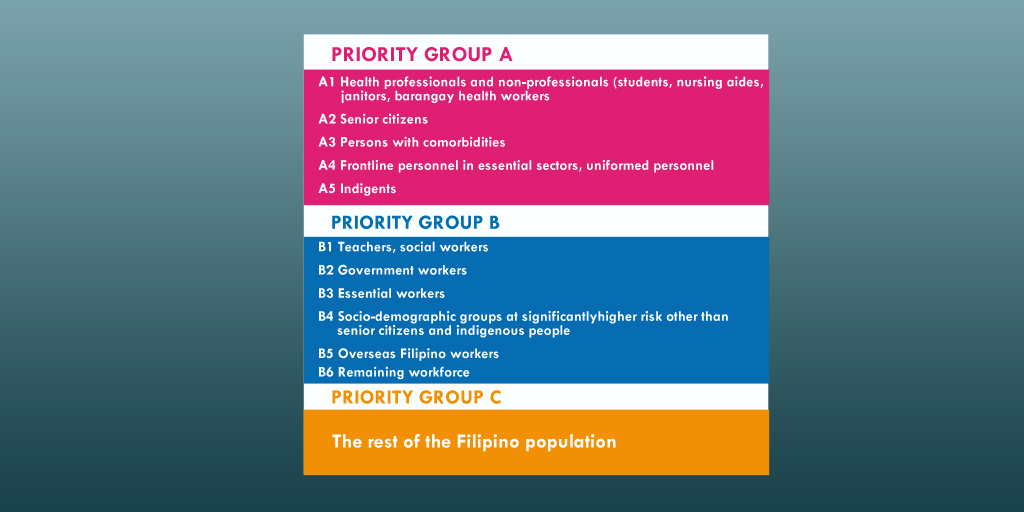 Source: Philippine News Agency (PNA)
Source: Philippine News Agency (PNA)
Ayon sa Philippine National Deployment and Vaccination Plan for COVID-19 Vaccines, nakakalap na ang pamahalaan ng ₱82.5 billion. Ilalan ito sa pagbili ng mga vaccine at iba pang mga gastusin sa pagbabakuna.
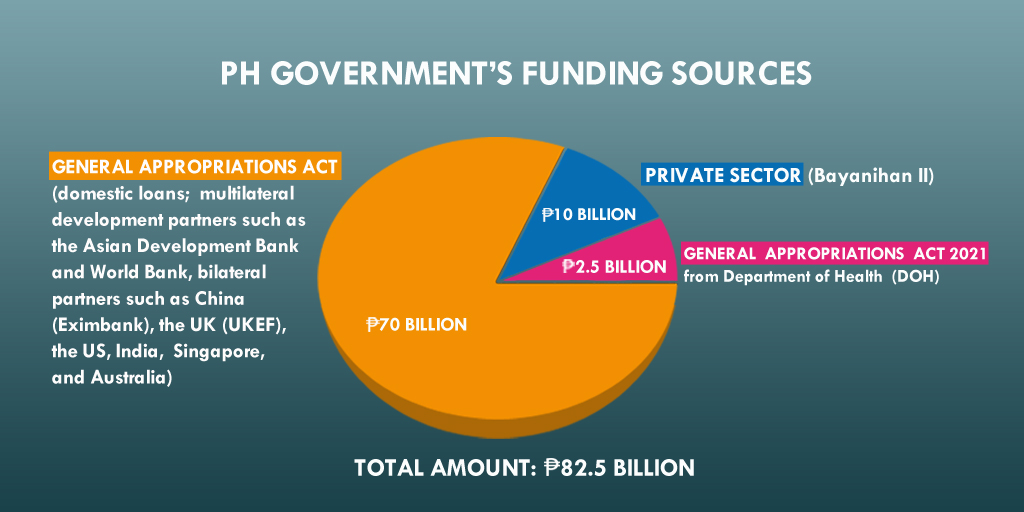 Source: DOH
Source: DOH
Nabanggit ni Department of Finance (DOF) Secretary Carlos Dominguez III na posibleng umabot sa ₱1,300 ang pagbabakuna sa bawat indibiduwal. Dagdag pa niya, mga 57 milyong Pilipino ang makikinabang sa ₱75-bilyong pondong inilaan ng pamahalaan sa pamimili ng mga vaccine. Ang natitirang populasyon ay paggagastusan ng mga LGU (local government unit) at pribadong sektor. Sa ilalim ng Bayanihan to Recover as One Act, pumirma ng kontrata ang lokal na pamahalaan, LGU at mga 300 pribadong kumpanya upang bumili ng 17 milyong dosis mula sa British pharmaceutical company na AstraZeneca. Ayon kay Joey Conception, ang Presidential Adviser for Entrepreneurship, kalahati ng mga dosis na bibilhin ng pribadong sektor ay ibibigay sa gobyerno, habang ang kalahati ay mapupunta sa mga empleyado ng mga kumpanya.
Nationwide Vaccination Drive
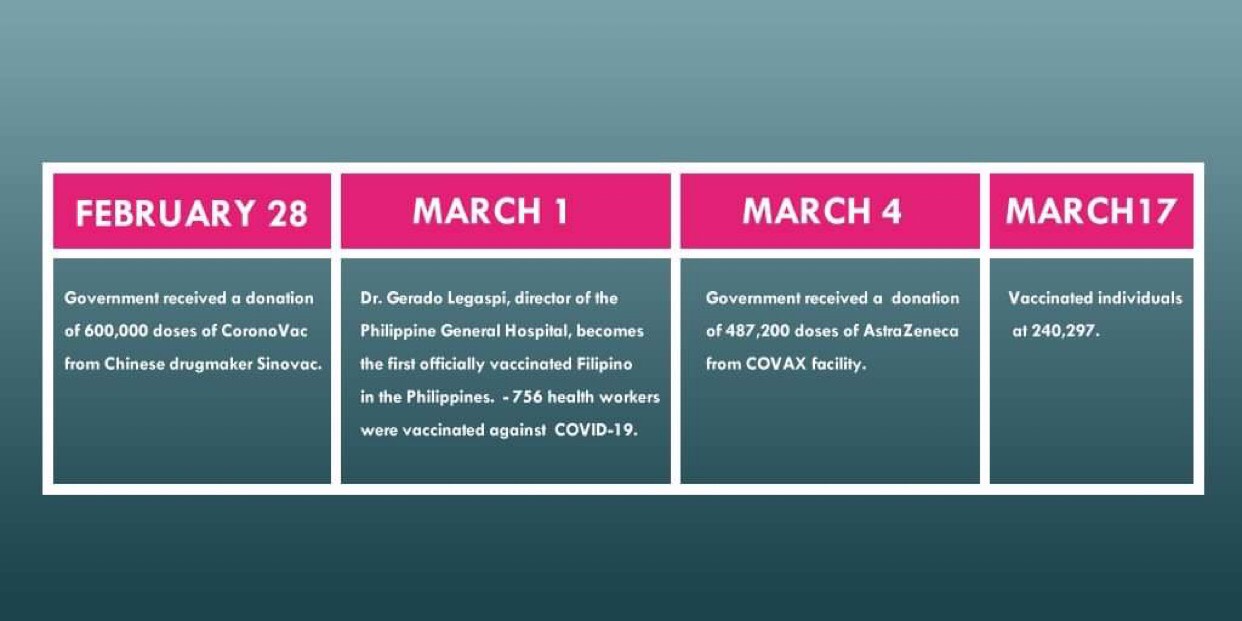 Sources: DOH, WHO, PNA
Sources: DOH, WHO, PNA
 Higit sa 480,000 dosis ng AstraZeneca vaccine ang ibinigay ng COVAX facility sa Pilipinas. (Photo: National Task Force Against COVID-19)
Higit sa 480,000 dosis ng AstraZeneca vaccine ang ibinigay ng COVAX facility sa Pilipinas. (Photo: National Task Force Against COVID-19)
Base sa tinatayang datos ng paglago ng populasyon mula sa Philippine Statistics Authority, bumuo ang pamahalaan ng three-year vaccination plan mula 2021 hanggang 2023. Inaasahan na sa 2022, maaari nang mabakunahan ang mga 16 years old pababa, habang meron nang COVID-19 vaccine para sa mga sanggol sa 2023. Ang mga binakunahan ngayong 2021 ay bibigyan pa ng booster shots sa susunod na mga taon.
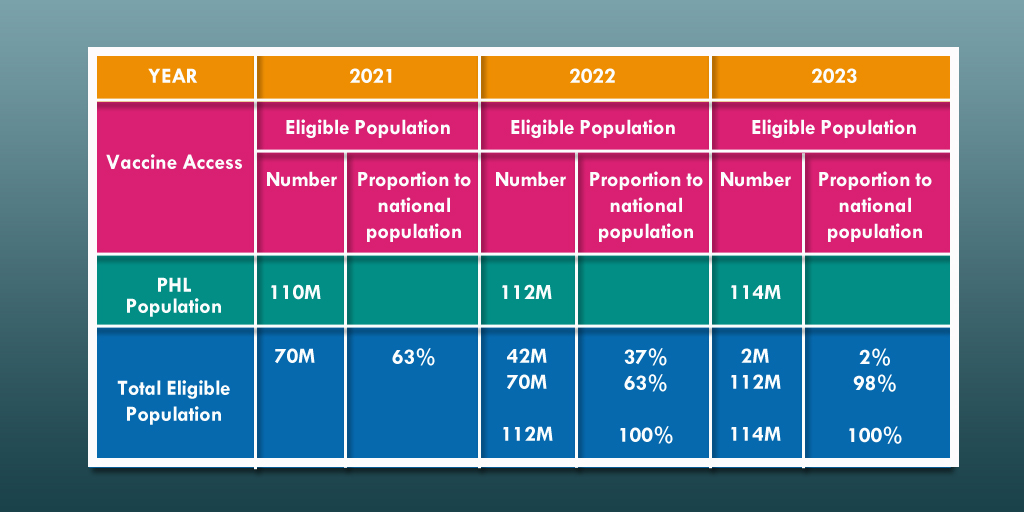 Source: DOH
Source: DOH
Pagkamit ng Herd Immunity
Kahit hindi pa alam ng WHO ang eksaktong porsyento ng isang populasyon na dapat mabakunahan upang makamit ang herd immunity, layunin ng pamahalaan ang mabigyan ng COVID-19 vaccine ang 70 milyong mga Pilipino ngayong 2021. Pero dalawang dosis ang kailangan para makumpleto ang pagpapabakuna— ibig sabihin, 140 milyong dosis ang dapat maiturok ngayong taon.
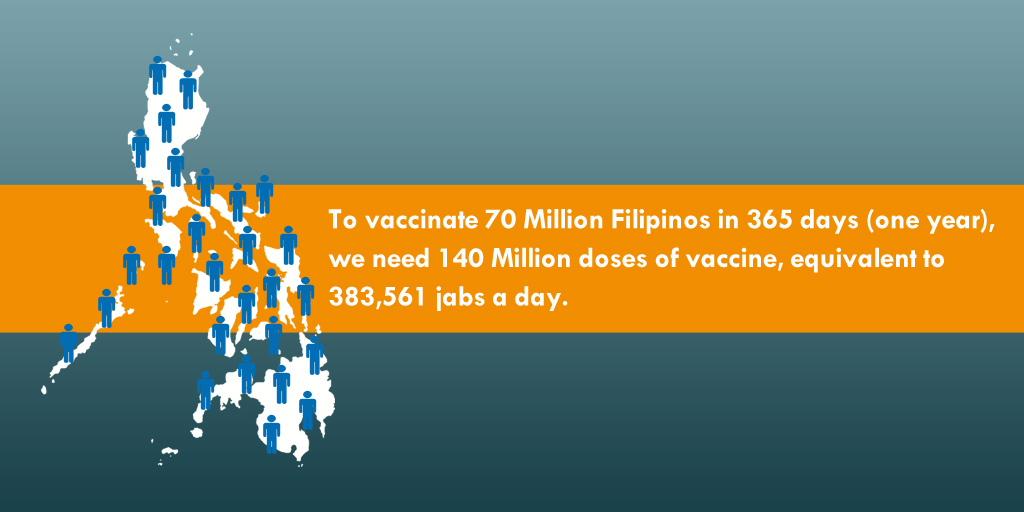
Base sa mga bilang na ito, dapat bilisan ng pamahalaan ang pagbabakuna para magkaroon ng herd immunity sa bansa—lalo na’t kailangang kailangan na ito ng ating ekonomiya.
Matagal pang haharapin ng bansa ang pandemya, at hindi pa natin alam kung kailan ito matatapos. Ngunit isang bagay ang maliwang: hangga’t hindi pa nababakunahan ang 70 milyong mga Pilipino, kailangan ng ibayong pag-iingat ngayong tumataas muli ang mga kaso ng COVID-19 sa bansa.
Tumatakbo ang oras, pero habang wala pang bakuna ang karamihan ng mga Pilipino, dapat sundin ang mga hakbang upang masiguro ang pansariling kalusugan at kaligtasan. Sa ganitong paraan pa lang natin maiiwasan ang sakit na patuloy na dumadagdag sa 2 milyong bilang na namamatay sa buong mundo.
Donna Lina with Agay Llanera
With the whole world racing to beat the pandemic, COVID-19 vaccinations are at the top of the global news pile. According to Bloomberg, the United States tops the list of having the most vaccinations so far at the rate of over 2 million doses per day.
Since the start of the Philippines’ vaccination drive last March 1, the latest tally of total vaccinations is now over 114,000. Besides the delayed arrival of vaccines, another hurdle the country’s mass vaccination faces is the Filipinos’ reduced confidence in vaccines. According to a recent survey, 46% of Filipinos are unwilling to get inoculated against COVID-19 even if the vaccine was proven safe and effective.
A Brief History of Vaccines
English Physician Edward Jenner is widely recognized to have made the first vaccination in 1796. After inoculating a child with smallpox virus, the vaccinee developed an immunity to the disease. Mass immunization following the development of the smallpox vaccine led to the disease’s global extermination in 1979.
The Centers for Disease Control and Prevention (CDC) acknowledges the crucial role of childhood vaccines in preventing the following diseases:
- polio
- measles
- diphtheria
- pertussis (whooping cough)
- rubella (German measles)
- mumps
- tetanus
- rotavirus
- Haemophilus influenzae type b (Hib)
For communicable diseases, vaccines act as extra protection for the body and the entire community. To get this kind of protection, a community must achieve herd immunity.
What is Herd Immunity?
Herd immunity or population immunity is defined by the World Health Organization (WHO) as the “indirect protection from an infectious disease that happens when a population is immune either through vaccination or immunity developed through previous infection.” WHO makes it clear that it supports herd immunity against COVID-19 through vaccination.
This is achieved through mass vaccination, enabling majority of the population to be immune to the disease. Scientists are still researching how much of the population needs to be inoculated for herd immunity against COVID-19 to take place. In the Philippines, the government announced its plans to vaccinate 100% of its adult population or about 70 million Filipinos.
COVID-19 Vaccination Plan in PH
Last February, the Inter-Agency Task Force for the Management of Emerging Infectious Diseases (IATF-EID) finalized the priority list for the COVID-19 vaccination drive.
 Source: Philippine News Agency (PNA)
Source: Philippine News Agency (PNA)
According to the Philippine National Deployment and Vaccination Plan for COVID-19 Vaccines, the government has accumulated ₱82.5 billion to cover costs of procuring vaccines, logistics, distribution and monitoring.
 Source: DOH
Source: DOH
With vaccination costs pegged at ₱1,300 per individual according to Department of Finance (DOF) Secretary Carlos Dominguez III, around 57 million Filipinos will benefit from the nearly ₱75-billion funds allocated by the government for vaccine acquisition. The remaining individuals are to be covered by the local government units (LGUs) and the private sector. Under the Bayanihan to Recover as One Act, the national government, local government units (LGUs) and about 300 Philippine companies signed an agreement with British pharmaceutical company AstraZeneca to procure 17 million vaccine doses. In this article, Presidential Adviser for Entrepreneurship Joey Concepcion said that half of the vaccine doses will be given to the national government, while the remaining half are for the companies’ workforce.
Nationwide Vaccination Drive
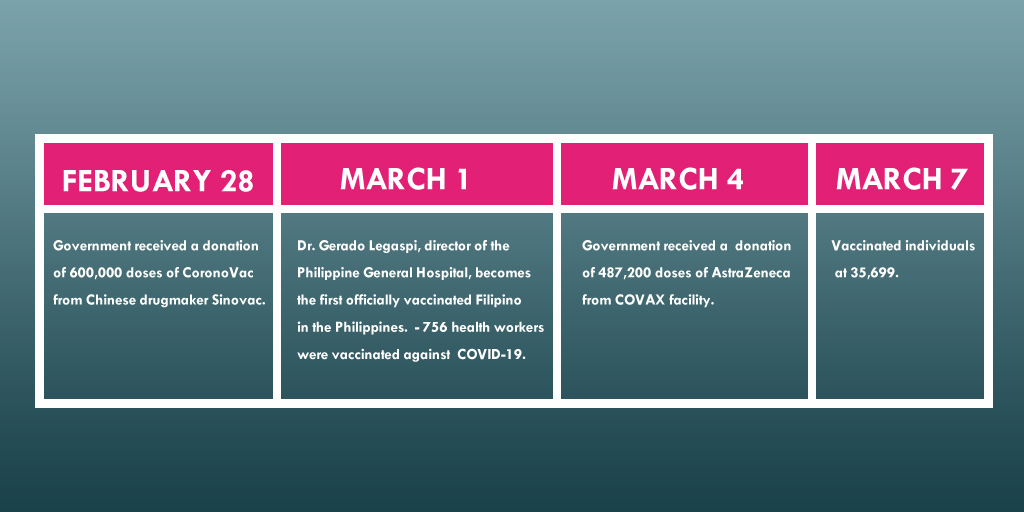 Sources: DOH, WHO, PNA
Sources: DOH, WHO, PNA
 Over 480,000 doses of AstraZeneca vaccine arrive in the Philippines from the COVAX facility. (Photo from National Task Force Against COVID-19)
Over 480,000 doses of AstraZeneca vaccine arrive in the Philippines from the COVAX facility. (Photo from National Task Force Against COVID-19)
With population projections from the Philippine Statistics Authority, the government developed a three-year vaccination plan from 2021 to 2023. The roadmap assumes that by 2022, those 16 years old and below may be allowed to take the vaccine, and that by 2023, newborns can be inoculated against COVID-19. Those who’d taken the shots in 2021 will be given booster shots in the succeeding years.
 Source: DOH
Source: DOH
Achieving Herd Immunity
Though WHO emphasizes that “the proportion of the population that must be vaccinated against COVID-19 to begin inducing herd immunity is not known,” the Philippine government’s goal of vaccinating 70 million Filipinos this 2021 aims to achieve herd immunity. Because each vaccination requires two doses, 140 million vaccine doses need to be rolled out in a year.

Based on such figures, the government needs to ramp up its vaccination drive to achieve herd immunity, and enable the country to recover both from the health and economic crises.
The country’s battle against the pandemic is still unfolding but one thing remains clear: until the crucial number of 70 million have not been vaccinated, Filipinos need to be on their toes as cases continue to surge.
Time is of the essence, but with majority having no means for vaccination yet, basic health and safety measures are still the strongest defense against this disease which continues to add to the global death toll of over 2 million.
